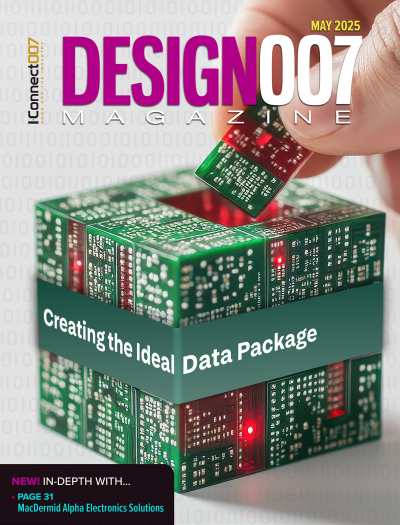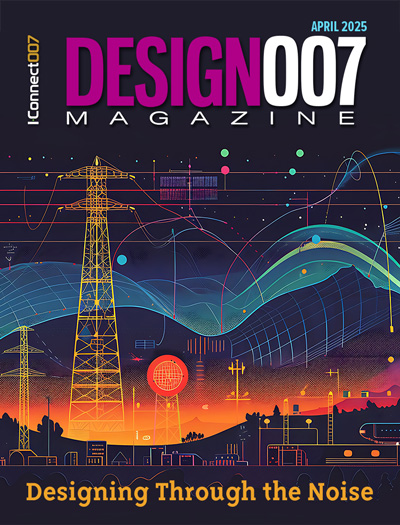-

-
News
News Highlights
- Books
Featured Books
- design007 Magazine
Latest Issues
Current Issue
All About That Route
Most designers favor manual routing, but today's interactive autorouters may be changing designers' minds by allowing users more direct control. In this issue, our expert contributors discuss a variety of manual and autorouting strategies.

Creating the Ideal Data Package
Why is it so difficult to create the ideal data package? Many of these simple errors can be alleviated by paying attention to detail—and knowing what issues to look out for. So, this month, our experts weigh in on the best practices for creating the ideal design data package for your design.

Designing Through the Noise
Our experts discuss the constantly evolving world of RF design, including the many tradeoffs, material considerations, and design tips and techniques that designers and design engineers need to know to succeed in this high-frequency realm.
- Articles
- Columns
- Links
- Media kit
||| MENU - design007 Magazine
RF and Microwave: No Black Magic
March 15, 2022 | Andy Shaughnessy, Design007 MagazineEstimated reading time: 5 minutes
I caught up with Ben Jordan after his class on RF and microwave at IPC APEX EXPO. Ben, an electrical engineer, explained how sitting through previous classes on this topic led to him developing his own class. “I wanted to bridge the gap,” he says, “with a class that makes the material approachable and teaches the intuitive nature of fields and waves and how they work in circuit boards.”
Andy Shaughnessy: Ben, I caught your class on RF and microwave. But you also have your own business, correct?
Ben Jordan: Yes, I do.
Shaughnessy: That’s great. Hanging out your own shingle and all that.
Jordan: I’ve actually had it as a side gig for about 10 years but didn’t do much with it. It started when, 11 years ago, I wrote an article for a hobbyist magazine called Elektor Electronics on power supply design. I wanted to release it and suddenly people wanted to buy a kit from me. Hobbyists from Europe were sending me orders, so I had to quickly ramp up and produce little electronic kits. I’m not doing that now because that’s not scalable, but I needed a business entity.
Shaughnessy: That’s very cool.
Jordan: I’ve been doing a little bit here and there, and whenever I train or teach at IPC, like this week, I can be paid through my business. But now I’m looking at making a change, hanging out my shingle as you said, and pursuing the business that will be more financially stable as well as give me time to pursue some of my more creative interests, like music.
Shaughnessy: Yes, exactly. So, tell me a little about the class I attended and some of the challenges you wanted to address with that.
Jordan: So, I’ve sat in on some great RF microwave classes in the past. Rick Hartley has a fantastic one; it’s dense. They’re all good. I studied electrical engineering and I’m a qualified engineer originally, but I never professionally did RF and microwave. I wanted to start doing it because everything is connected wirelessly now. I went back to all my old engineering texts to review the material I studied in university. There’s a lot of math and a lot of theory, but what I discovered is that none of it talked about printed circuit boards beyond, “This is a stripline and this is a microstrip and this is how you determine the impedance.”
I realized something was missing in our community. There are many PCB designers who may not even be degree qualified and believe they can’t do RF and microwave board design because they’ve never been trained in microwave engineering. I would often hear that people see it as some kind of black magic, like, “Those are the wizards in the office down in the corner.” I wanted to bridge the gap with a class that makes the material approachable and teaches the intuitive nature of fields and waves and how they work in circuit boards. How do they work? What’s the effect on the materials and how you actually design the shapes and decide what size they should be for things like filters and impedance matching of circuits?
That grew into another class I developed for antenna design; we have a lot of animations showing the right visualization of how the different types of circuit board antennas work so people can understand them and then dimension them correctly for the target purpose.
Shaughnessy: A lot of it is counterintuitive to a typical design. A PCB designer doesn’t want things to be an antenna, but in RF you do.
Jordan: Some you do and some you don’t. By learning antenna theory, you can also learn how to be a better signal integrity aware digital designer as well because exactly the same principles apply. For example, at the end of my class yesterday, I was showing a design of a slot antenna on a printed circuit board. It’s essentially an impedance-controlled trace with a very specially-sized notch on one side of the board in a plane; that’s an opening. On the other side, you have the micro strip that crosses over the notch with a precise length. But what happens at the frequency of resonance is that it causes very good radiation. It’s a great antenna.
Just at the moment I was showing this, Insulectro’s Mike Creeden stuck his head into the classroom, raised his hand, and said, “This is also why you don’t cross ground planes in a digital design. You’ve just created an antenna without realizing it.” So, yeah, it’s very good. I find that the attendance of my subject is usually pretty good, even in these times when a lot of people still aren’t coming to shows yet.
Shaughnessy: What advice would you give to someone who’s getting into wireless and having to deal with the audio, the analog. You must deal with analog digital, mixed signal, and all this good stuff.
Jordan: There are books of advice, but I would just not to be overwhelmed and don’t keep telling yourself it’s black magic. You can do it if you think you can. Just start on the road, watch the RF and microwave series I did a few years ago as an intro.
Shaughnessy: Is that on YouTube?
Jordan: It was on the Altium YouTube channel because I was working for Altium at that time. I’m not anymore, obviously, but start there. Because we talk about materials, the basic principles and the mathematics are not hard. I’m not trying to teach people how to write their own software to do finite difference time domain or FEM.
There are plenty of software companies that have really dialed that in. There are even a lot of free open-source tools, which I talk about in my class, that do it well. And of course, moving forward with my own company, I will be focusing on turning this into a more staged, in-depth course. There will be more actual design examples so that you can build something yourself, have something that works, and understand how it’s working. That’s my goal for this year.
Shaughnessy: I like your advice: Don’t be overwhelmed by it.
Jordan: That’s right, just start. The journey of a thousand miles starts with one step.
Shaughnessy: Thank you for talking with me.
Jordan: Thank you, Andy. Good talking to you again.
Suggested Items
Siemens Turbocharges Semiconductor and PCB Design Portfolio with Generative and Agentic AI
06/24/2025 | SiemensAt the 2025 Design Automation Conference, Siemens Digital Industries Software today unveiled its AI-enhanced toolset for the EDA design flow.
Cadence AI Autorouter May Transform the Landscape
06/19/2025 | Andy Shaughnessy, Design007 MagazinePatrick Davis, product management director with Cadence Design Systems, discusses advancements in autorouting technology, including AI. He emphasizes a holistic approach that enhances placement and power distribution before routing. He points out that younger engineers seem more likely to embrace autorouting, while the veteran designers are still wary of giving up too much control. Will AI help autorouters finally gain industry-wide acceptance?
Beyond Design: The Metamorphosis of the PCB Router
06/18/2025 | Barry Olney -- Column: Beyond DesignThe traditional PCB design process is often time-consuming and labor-intensive. Routing a complex PCB layout can consume up to 30% of a designer’s time, and addressing this issue is not straightforward. We have all encountered this scenario: You spend hours setting the constraints and finally hit the Go button, only to be surprised by the lack of visual appeal and the obvious flaws in the result.
Robust AI Demand Drives 6% QoQ Growth in Revenue for Top 10 Global IC Design Companies in 1Q25
06/15/2025 | TrendForceTrendForce’s latest investigations reveal that 1Q25 revenue for the global IC design industry reached US$77.4 billion, marking a 6% QoQ increase and setting a new record high. This growth was fueled by early stocking ahead of new U.S. tariffs on electronics and the ongoing construction of AI data centers around the world, which sustained strong chip demand despite the traditional off-season.
Cadence Advances Design and Engineering for Europe’s Manufacturers on NVIDIA Industrial AI Cloud
06/13/2025 | Cadence Design Systems, Inc.At NVIDIA GTC Paris, Cadence announced it is providing optimized solutions for the world’s first industrial AI cloud in collaboration with NVIDIA.


